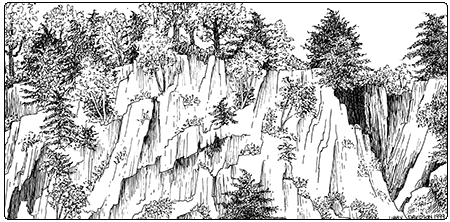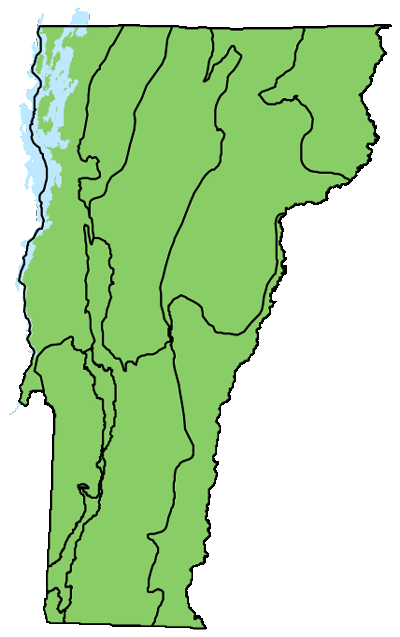Ecology and Physical Setting 
Temperate Acidic Cliffs are found at lower elevations (generally below 2,000 feet) in areas where Northern Hardwood Forests and forests of warmer climates are dominant. Bedrock is acidic, and the sparse soils found in cracks and on ledges are often dry due to sunlight and to the loss of water. Occasionally, groundwater seeps from cracks in the rock, or from soils above, creating miniature steep wetlands. The structure of these cliffs varies depending on the bedrock type. Massive rocks such as granite create large open faces with few cracks and therefore little soil or vegetation. Platy rocks like schists or slates may have numerous small ledges where soil can accumulate. These rocks are less stable, however, so soil may not stay in place for very long.
Vegetation
As is the case with all cliff communities, vascular plants are sparse. Occasional trees may take hold where soil has accumulated, and shrubs—especially bush-honeysuckle—are common. Typical herbs include hairgrass, poverty grass, rock polypody, and wild columbine. Mosses persist in moist, shaded places. If these places stay permanently saturated from seepage, they can even support round-leaved sundew and other wetland species. Lichens do especially well in these communities, in shaded as well as sunny places. Rock tripe is a typical and conspicuous lichen on Temperate Acidic Cliffs.
Wildlife Habitat
Peregrine falcons, turkey vultures, and common ravens all nest on ledges and crevices of Temperate Acidic Cliffs, where the chicks are safe from terrestrial predators. Eastern phoebe is a harbinger of spring—one of the first migrants to return to Vermont. This flycatcher now nests primarily on sheltered surfaces of houses, barns, bridges, and other structures. But small cliffs in the woods with a supporting shelf and sheltering overhang are one of the natural nesting sites for phoebes. The rare eastern small-footed bat hibernates in caves but prefers to roost during the summer in warm rock crevices, such as occur on south- and west-facing cliffs.
Related Communities
- Temperate Calcareous Cliffs support calcium-dependent species and tend to have higher overall species diversity, though this diversity is dependent on moisture availability as well as the nature of the bedrock.
- Boreal Acidic Cliffs support a greater abundance of northern species such as red spruce, balsam fir, heart-leaved paper birch, three-toothed cinquefoil, and brownish sedge.
- Temperate Acidic Outcrops are often found adjacent to Temperate Acidic Cliffs, at ledge crests where the slope abruptly or gradually levels out. When the two communities are adjacent, they share many species in common.
- Red Cedar Woodlands are found at ledge crests in the warmer parts of the state, on acidic to circumneutral bedrock, often directly above Temperate Acidic Cliffs.
Conservation Status and Management Considerations
Many Temperate Acidic Cliffs are found on conserved lands, but these cliffs and their plants and animals are still vulnerable to disturbance and erosion. Rock climbers should use care to avoid damaging plants or eroding fragile soils that have accumulated over millennia. Many of Vermont’s cliffs are closed to recreational activities during the peregrine falcon nesting season.
Distribution/Abundance
Temperate Acidic Cliffs are common throughout Vermont at lower elevations, generally below 2,000 feet depending on the latitude and biophysical region. The largest examples occur in the Mountain and Piedmont regions. Similar communities are found throughout the northeastern United States and adjacent Canada.
Characteristic Plants
Trees
Red oak – Quercus rubra
White pine – Pinus strobus
Eastern hemlock – Tsuga canadensis
Red maple – Acer rubrum
Paper birch – Betula papyrifera
Eastern red cedar – Juniperus virginiana
Shrubs and Woody Vines
Purple-flowering raspberry – Rubus odoratus
Bush-honeysuckle – Diervilla lonicera
Virginia creeper – Parthenocissus quinquefolia
Common juniper – Juniperus communis var. depressa
Low sweet blueberry – Vaccinium angustifolium
Black huckleberry – Gaylussacia baccata
Herbs
Harebell – Campanula rotundifolia
Wild columbine – Aquilegia canadensis
Heart-leaved aster – Symphyotrichum cordifolium
Rock polypody – Polypodium virginianum
Poverty grass – Danthonia spicata
Hairgrass – Deschampsia flexuosa
Lichens
Rock tripe – Umbilicaria sp.
Non-native Plants
Canada bluegrass – Poa compressa
Rare and Uncommon Plants
Drummond’s rock cress – Boechera stricta
Small-flowered bitter cress – Cardamine parviflora
Rock whitlow-grass – Draba arabisans
Longleaf bluet – Houstonia longifolia
Associated Animals
Eastern phoebe – Sayornis phoebe
Turkey vulture – Cathartes aura
Common raven – Corvus corax
Rare and Uncommon Animals
Eastern small-footed bat – Myotis leibii
Peregrine falcon – Falco peregrinus
Columbine duskywing – Erynnis lucilius
Places to Visit
Haystack Mountain, Pawlet, Friends of Haystack
Marshfield Ledges, Marshfield, Groton State Forest, Vermont Department of Forests, Parks, and Recreation
Bolton Notch, Bolton, Preston Pond Conservation Area, Town of Bolton
Mount Ascutney, West Windsor, West Windsor Town Forest
